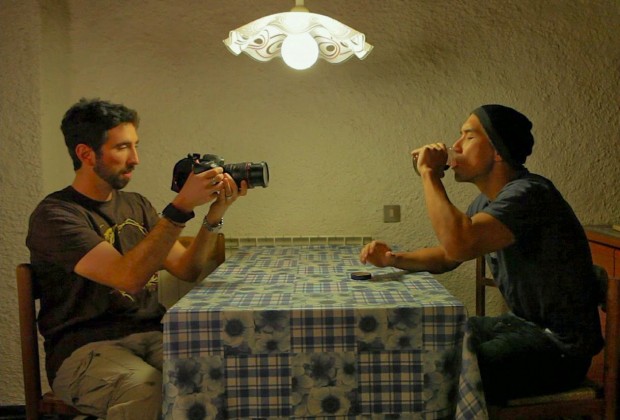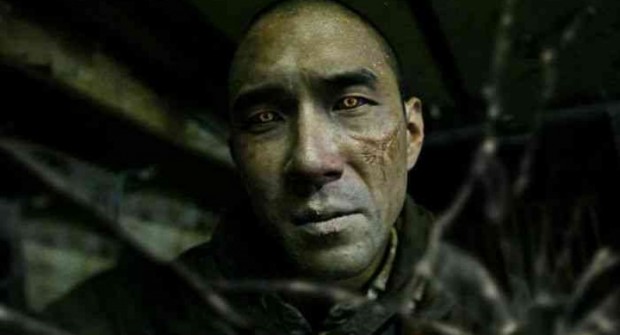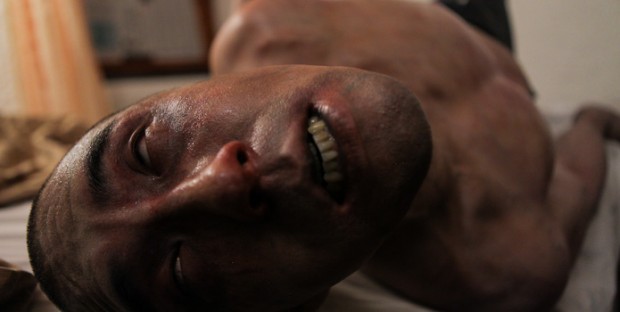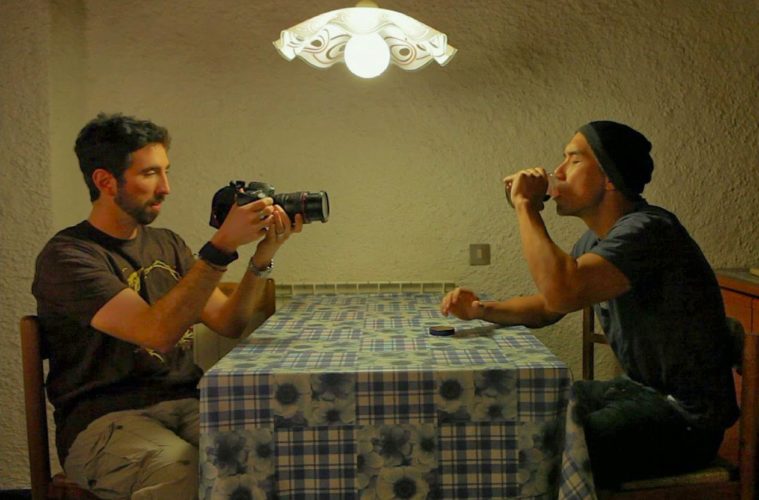
Some films are simply fun to talk about, something that’s certainly the case with Afflicted, particularly last year during its Fantastic Fest premiere. Following tremendous buzz, the film ended up garnering the awards for top screenwriting, directing, and best picture in the horror features category. Released this past week by CBS Films, the film starts with two long-time friends, Clif and Derek, on a trip through Europe with cameras in tow. Clif is an aspiring filmmaker and wants to put his latest equipment to the test so he rigs harnesses and everything else to shoot a video blog of the entire journey. Things change when Derek is attacked one night and starts to tumble down a dark hole of health issues and more. Just when things can’t get any worse, Derek gets a bit better. But that’s not good for anyone.
I sat down with the two filmmakers, Clif Prowse and Derek Lee, who both wrote, direct, and star in their first-time feature film to talk about the extensive use of practical effects, why they chose AVM as an illness, finding a bromance balance, why they shot the biggest scenes first, and some major spoilers. I’d recommend avoiding the last section of the interview for obvious reasons but everything else should give you a taste. Afflicted is currently on VOD platforms and in limited theatrical release and one can read the conversation below.
The Film Stage: I’m sure you’ve heard it a lot by now, but this is quite an impressive first feature.
Clif Prowse and Derek Lee: Thanks.
While it’s a small budget film, it doesn’t seem to cut any corners in the look and feel. Do you think that part of that is due to the fact that you have so many practical effects?
Lee: Paring down the number of shots that required visual effects and photo-real visual effects was definitely part of our game plan in order to achieve this idea. One of our guiding lights just going into our first feature film was making sure it wasn’t one of those films where people are like, “Oh, it looks pretty good for the budget you have.” You know what I mean? The film just has to work, and if you pick an idea that’s too big and we can’t achieve on a budget, there really isn’t an excuse. You can’t say, “Oh, it’s only because I had X number of dollars.” Well, maybe you shouldn’t have made a film that crazy big. So we had to keep our gaze as contained as possible. Now, having said that, we may have gotten a little ambitious with throwing people from buildings and jumping through walls. But for the most part, because those were practical. For instance, the wall was with our stunt guy literally running into a wall filled with squibs and showing up on the other side. That stuff all reads. It’s balancing out when you only have a few effects shots. If you can’t fix all your problems in post, you have to do practical, for sure.
Prowse: And that’s where you can sell the more spectacular and fantasy-based elements in the movie in those six visual effects shots, then the rest of it can be practical and you don’t feel like you’re missing stuff. We didn’t want the audience to feel cheated so hopefully we have enough stuff on screen to make you feel like you’re watching something supernatural happening in a real life environment — that was the core concept of the movie.
You are stuntmen, as well as actors, but I know how often that isn’t the exact case. How much of that was you? Every time we see your face, Derek, is that you doing that action?
Lee: [Laughs] I’d love to say that. I would have asked for that if it were possible, but I am not trained. My stunt double is Brian Ho, and he’s basically a faster, stronger, cooler version of me.
[Everyone laughs]
Lee: He makes everything that Derek the character needs to do look awesome, easy, and seamless. He’s actually so good that when he would do the stunts the first time through, he would be slick and he would be cool and land all of his jumps, but the character is just figuring this out. He’s awkward. He’s not an athlete. So we’re like, “OK, Brian, we need you to messy up a bit. Screw up the landing. Just get loosey-goosey about it.” To his credit, within a couple takes he became Derek. He’s full-on actor and he knew how to capture what it was to be my character doing all these insane things for the first time. Having said that, I would have loved to do some of the stunts. It’s a lot of fun getting strung up on a 110-foot cable and getting launched into space. I’m not shy, but there’s a levelheaded production assistant that says, “You know, your lead actor can’t do that. Don’t.” So, that’s not me.

Well, I want to talk about one scene in particular. You punch through a wall. Was that you?
Lee: Yeah, that counts! That was one of our fun, practical gags. We had to spend a lot of time writing the scene so we knew we could get the right angle to see that. But basically, there’s a cut-out of the wall with some plaster and fake bricks. But, it wasn’t fun to punch. It was a little heavy and hurt a little bit. We did three takes and we used the third take. For that much, I’m very thankful to Clif because when he asked to do another one it was like, “You better use it.”
I imagine you feel like a pretty big bad-ass after that sequence.
Lee: Oh, definitely. And I’m pretty sure I hit [Clif] on every take with the debris.
Prowse: Yeah… you did.
[Everyone laughs]
Prowse: But what am I going to complain about? He’s punching through a wall. During production, we built that wall. First take, it was dry. Then we had to build it again, which took a while. So it was actually wet the second time. It hurt. That was one of the very first things we shot. So the principle guiding light of the movie was that we need to shoot all the most crew-intensive and expensive things early in the shoot with the guys. Then, as we’re running out of money, we’re shooting simpler and simpler things so that by the end of the shoot, we’re shooting the stuff where we’re just running around Barcelona with a camera and a microphone. So that was one of the very first things that we did. It definitely was one of those moments where we had done the first two takes and had come back and thought we could do a third if we had time. It was worth it. The scene that appears in the movie now, there’s no dialogue. There was a whole part where it was an exchange back and forth but Derek says one line in that scene and it’s him putting his fist through a wall. That says everything about what he needs to say. It was way stronger that way.
How many cuts of this film were there? Was there a three hour version out there?
Prowse: The first version that our editor put together was about two hours long. So that was the longest version we ever had.
So it was a pretty tight script or was it just during production that you stripped things away?
Prowse: What happened was that we had a script that we started from, but then we allowed for a lot of improvisation around that to give it as much of a natural feel as possible. As soon as you start to feel like you’re actors reading lines, it ruins the aesthetic. It’s about making this feel as real as possible. So any time anything felt rehearsed or too perfect, or perfectly framed, then you’re losing the audience. Part of it was scripted and part of it was going through documentary footage and there’s a 40-minute scene at a table. You’re pulling those one or two nuggets that really captures the spirit of the beginning of the trip.
One thing that struck me last night during the screening was just how sharp and fun the documentary stuff looks. It’s really well done and I’ve got to say, it made me want to watch that show. How much fun did you have with that and how much work was put in to achieve that?
Lee: It was crazy fun to shoot and there’s lot of it. There was a long-standing debate of just how much you want to spend with the guys before you go off. The more you care about the characters, the more they feel real, the more the trip feels real, the higher the stakes. As we’re figuring this out we had a skydiving part of the montage, and it’s actually a full, fleshed-out scene. It’s great. It’s about the bromance between the two characters and about Clif challenging his fear of heights and it’s about Derek getting over his own demons about his AVM. It was a great scene and while it was thematic and important to the characters, it was slowing down the movie. But it was literally tested as one of the favorite scenes by audiences and we had to cut it out because it was killing the movie. So what do you do? We actually had a cut of the film that went 27 minutes before the bite. That’s 27 minutes of just hanging out with these guys, living their lives and having a good time. People actually said that was their favorite part of the movie.
So they’re saying they loved the first portion of your 90+ minute film. It’s like, “That’s great, guys, but what about everything else?”
[Everyone laughs]
Prowse: Do you remember when that guy was thrown from the building?
[Everyone laughs]
Lee: So it was a tough thing. It was killing a lot of our favorite moments. We just couldn’t keep it. It’s a lesson on succinct storytelling. You can have the most amazing scenes that don’t stay because you are not staying on theme.
Prowse: I think we also wanted to have something that felt like there’s a reason why these guys are out there with their cameras rolling. You get a sense of who they are and what they’re aspiring to. So you get a sense of them and then the movie takes a huge turn and that was really exciting because we wanted to make you feel like you were watching one movie and all of a sudden a freight train comes in a knocks this into a totally different kind of movie. So part of that was if you could get people to buy in and enjoy the first part and feel like, “Oh, I would watch this show these guys are putting on.” That’s a huge compliment that you gave us. We didn’t want it to feel like you’re waiting for something else to happen.
Lee: The film is kind of predicated on the idea that you actually at least partially like the characters. If you don’t like the characters, we’re in big trouble. We needed to spend just enough time to get you to like them.
Prowse: And it’s important to us, because we are, that you feel that we’re normal, geeky guys just having fun with the camera and joking around with friends. Everyone has those relationships. We wanted you to feel the authenticity of that.
A small, but key point is AVM. You just mentioned it. That could be anything. It could be cancer. Or anything else. Why AVM? Does that have any kind of personal connection?
Lee: Thankfully, no. AVM, if it’s in your brain, it is quite dangerous. We spent a lot of time researching a lot of different illnesses. It is very tricky to come up with something and treat it respectfully and use it in a narrative. There’s an exploitative nature to that that we’re not comfortable with and using a sickness for our movie where people actually have this problem. So this AVM happened to work for us in the narrative structure. That’s ultimately why we chose it. It worked for the character motivations, would it be reasonable for him to go on the trip, how would his family feel about it, what would his friend feel about it. What kind of dangers would he face while on the road? All of those factors played a factor in why we chose that over anything else. And ultimately we were just hyper-conscious of not abusing the real sickness.
Prowse: I think the other thing we wanted to do is get away from the norm. The use of someone having brain cancer or a brain tumor is pretty pervasive. One of the reasons we chose AVM was that we wanted it to be specific and personal that felt real. Because the use of brain cancer is used a lot we thought it would make it feel it could be more easily dismissed as fiction. We wanted something that we could introduce to the audience that was not necessarily in everyone’s consciousness beforehand so it felt random enough that it could feel real and hopefully at the same time, as Derek said, you’re treating it with the respect it deserves because you are explaining it.
**MAJOR SPOILERS AHEAD**

This will be a spoiler, but we’ll roll with it. Last night you mentioned that you aren’t big fans of the vampire genre. You hinted that this was a rebellion against where it’s at currently. Were you fans of the things out there now that have been a bit of a response to — well, let’s go ahead and name it — Twilight and those types of riffs on the vampire genre that don’t hold the same appeal to a lot of people? Maybe Guillermo del Toro’s The Strain trilogy or 30 Days of Night?
Lee: Elephant in the room!
[Everyone laughs]
Lee: We don’t really want to call out anything in particular, but vampires in pop culture right now are less interesting to us because they’re so not scary. Because they’re not curse-based. It’s just kind of like a laugh riot right now. It’s not that we weren’t fans of vampires. I think they’ve existed in our culture, in all cultures — they’re are even Asian vampires, and I think that’s for a reason. There’s something sinister, scary, and cool about blood-sucking demon spirits. But what we wanted to do with it is ask what would it be like if it actually happened? What would happen if, hey, it was you and I? What if we shot a movie like that? We just ended up there. We weren’t necessarily hating on those vampires. It was more like, “What is the vampire tale we want to tell?” Then it ended up being this very grim, biological… only give him the powers we felt would make him the ultimate predator. Don’t gussy it up with a lot of magic and bells and whistles. Keep it simple, keep it brutal, and make it curse-like.
Prowse: I think, also, the stylized and sexualized vampire genre… like True Blood, they do a really good job with that. But they’ve done that. So we wanted to look at something in a new way and the lens of reality was something that got us excited about it. It’s not that we hate those other movies and shows, it’s just, if we reimagine it in a very dark way, what would it do to a person to have to consume human blood and flesh and to kill people? What would that do to you emotionally and psychologically? That would just destroy you. That is a very dramatic journey for a person to go on. That’s what excited us about it. Other movies that we looked at were Let The Right One In [and] the horror aspect of 30 Days of Night was something we dig.
The five day thing. Did you have a seven day rule? What was it about five days?
Prowse: That’s an interesting question. What had happened was that we wanted to base it off of when Derek initially gets turned. It had to be that process where his body is adapting and changing and then all of a sudden it becomes hungrier and hungrier. So the pace of the movie helped determine that. We needed to get through that. If that took place over the course of a month, there’s not a lot of stakes to that. We needed it to escalate quickly. We also wanted it to be something that over the course of the movie, Derek is like, “Oh, man, I couldn’t do this every 10 days.” That’s what he thinks it is because that’s when he’s pushing his body to the limit.
That’s when he has to.
Prowse: Yeah, that’s when you’re pushing your body too far and at a certain point your body won’t allow you to do that and it will take over. You need to be consuming people even faster. What you thought was the curse is even worse then you think it is.
Lee: That time span is also part of a very complicated discussion about the lore behind vampires. Asking questions like, and it doesn’t show up in the movie, but you still as a writer and filmmaker have to ask, “What are other vampires doing? How many of them are there? If they’re all murdering, say, every day, why don’t we know about them?” Like, literally, the population is being trimmed by these vampires on a very global, epidemic level, you would notice that if they had to kill three people a day. But if they only have to kill one person a year, then they’re not even a statistic. So there was an awareness about all of that. So, if you make it once every five days, what does that mean? We had to ask a lot of questions like that and establish our mythology. Making sure we didn’t contradict ourselves. Keeping everything feeling semi-biological and semi-realistic.
Prowse: And urgent.
Afflicted is now available on VOD and in limited release.

